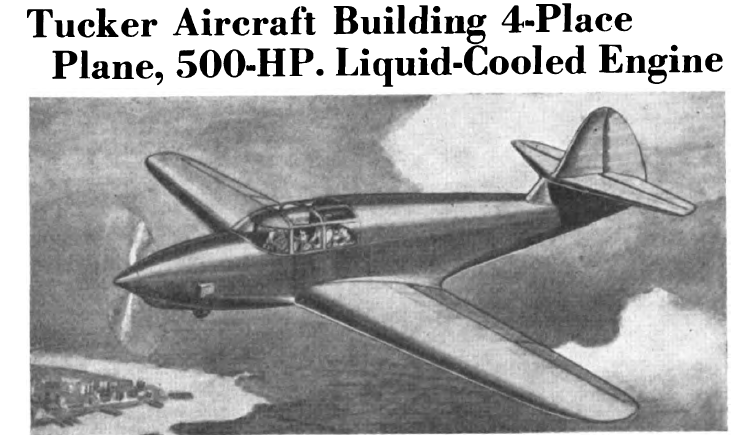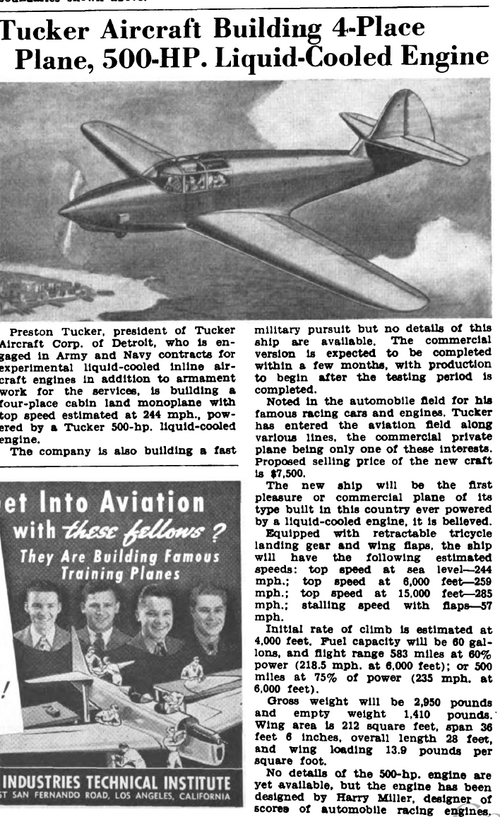You are using an out of date browser. It may not display this or other websites correctly.
You should upgrade or use an alternative browser.
You should upgrade or use an alternative browser.
Tucker Four-Place Light Aircraft Project
- Thread starter hesham
- Start date
- Joined
- 29 July 2009
- Messages
- 1,529
- Reaction score
- 1,548
It is the same manufacturer as the XP-57. The configuration and overall appearance of the civilian aircraft version has similar lines and planform of the fighter version. Tucker was innovative in his designs.
The article claims that its the first civilian aircraft designed with a liquid cooled engine, however there were at least a few US aircraft that come to mind, including the Aeromarine 50, Pitcarn Fleetwing, and WACO 9, which used liquid cooled engines. Curtiss, Packard, and Wright built liquid cooled engines primarily for the military in the 1920s and 30s, but some were used in civilian aircraft.
The move to air cooled engines became more evident in the 1930s as the lighter weight of air cooled engines and their very good performance made them better choices for light aircraft designers.
The engine in the proposed design is the Tucker 500 hp engine developed by Harry Miller. Any more information on the engine?
The article claims that its the first civilian aircraft designed with a liquid cooled engine, however there were at least a few US aircraft that come to mind, including the Aeromarine 50, Pitcarn Fleetwing, and WACO 9, which used liquid cooled engines. Curtiss, Packard, and Wright built liquid cooled engines primarily for the military in the 1920s and 30s, but some were used in civilian aircraft.
The move to air cooled engines became more evident in the 1930s as the lighter weight of air cooled engines and their very good performance made them better choices for light aircraft designers.
The engine in the proposed design is the Tucker 500 hp engine developed by Harry Miller. Any more information on the engine?
- Joined
- 31 July 2013
- Messages
- 546
- Reaction score
- 1,074
According to https://www.secretprojects.co.uk/threads/i-present-the-tucker-xp-57.34543/, the engine was a variant of the standard Miller automotive unit with the L-510 being basically two 255 cu. in. four-cylinder engines joined end to end. The crankshafts were connected in the center and the power to the propeller driveshaft was taken off that point, the shaft was to run beneath the engine. Obviously in the above light aircraft model, the engine is fitted in the front , unlike the XP-57 which had a mid-mounted arrangement similar to the P-39 & P-63.
- Joined
- 25 July 2007
- Messages
- 3,873
- Reaction score
- 3,181
The engine in the proposed design is the Tucker 500 hp engine developed by Harry Miller. Any more information on the engine?
I was about to say the same
See: https://www.secretprojects.co.uk/threads/i-present-the-tucker-xp-57.34543/#post-463439
"Manufacturer"? Preston 'fast-talking pitchman' Tucker never manufactured any aircraft, orIt is the same manufacturer as the XP-57. The configuration and overall appearance of the civilian aircraft version has similar lines and planform of the fighter version. Tucker was innovative in his designs.
The article claims that its the first civilian aircraft designed with a liquid cooled engine, however there were at least a few US aircraft that come to mind, including the Aeromarine 50, Pitcarn Fleetwing, and WACO 9, which used liquid cooled engines. Curtiss, Packard, and Wright built liquid cooled engines primarily for the military in the 1920s and 30s, but some were used in civilian aircraft.
The move to air cooled engines became more evident in the 1930s as the lighter weight of air cooled engines and their very good performance made them better choices for light aircraft designers.
The engine in the proposed design is the Tucker 500 hp engine developed by Harry Miller. Any more information on the engine?
much of anything for that matter. The abortive post-war car was as close as he ever got to being an actual manufacturer. Most of Tucker's "innovative" designs were the creations of other people. Those wonderful advanced ideas for his car which he supposedly had before WWII? A lot of them show up in drawings of Miller concepts that date back to early '30s, including the use of a rear-mounted flat engine, individual torque converters directly mounted to the wheels etc., indeed the origins of the majority of 'high-tech' concepts that Tucker couldn't pull off are found in the Miller back catalog. Harry was a very imaginative man who was constantly coming up with new ideas, many of which were well beyond the technology of the time or simply wouldn't work, Leo Goosen and Fred Offenhauser served to ground Harry's flights of fancy and limit the work to reality, and to get it done because Harry had a tendency to quickly lose interest once a project moved from the idea to the manufacture stage and run off in pursuit of another idea. He made a lot of money very quickly at different times and blew through it just as quickly. After the company folded and Harry was out in the wild, things didn't go as well and once fast-talking Tucker hooked up with him things didn't get any better - see the 1935 Ford-Miller Indy car debacle for a typical example of Tucker overpromising.
Mark Dees "The Miller Dynasty", 2nd edition, has a chapter on Harry's final projects which contains details on the sad joke that was the Tucker Aviation Corporation and the pathetic tale of the XP-57, which mostly consisted of Tucker making pie-in-the-sky promises while always needing more money - just one more payment and it'll all be good. The Army finally had enough and pulled the plug after an audit, Tucker was claiming 85% completion of the airframe, the Army audit report stated that it was less than 25% complete.
As to the L-510 engine, the two 255 cu.in. assemblies were based on the Gulf-Miller four engine of 1937 which was in turn based on an unbuilt 255 cu.in. 1933 aero-engine design that was developed from the 220/255 racing engine, the design that lived on as the famed Offenhauser. Which had originated as a 151 cu.in. engine for boat racing, which soon found its way into cars with the result that so many were clamouring for one that Miller had Leo Goosen enlarge it to 220 cu.in. as a dedicated car engine. When Miller's company folded in the early '30s head machinist Fred Offenhauser took the designs, patterns and some of the heavy machine tools when he left, in lieu of all the back pay he was owed.
Many L-510 components survived and occasionally they come up for sale even today. The
engine was the only part of the XP-57 project that produced any results. One set of components was used to build up a four that was used in a restoration of one of the Gulf-Miller Four racing cars, this was because the engines had been removed from the two cars while they had been in the possession of Preston Tucker (that guy again) and the collector who finally came into possession of them refused to sell one to the restoration project. This has since changed and the original engines are back with the cars.
Evidently the two halves of the engine were each to have a separate supercharger with a variable speed "hydraulic drive" of which no details are known, it's been speculated that it may have been a torque converter arrangement of some sort. The main deviation from the classic Miller layout is a horizontally split crankcase, split low on the sump, rather than a barrel crankcase, and a separate head. Most Miller engines had the head and cylinder block(s) cast en bloc which were then mounted to the barrel crankcase casting.
Horsepower was to be 720hp+ take-off and 650hp at 20,000', which isn't bad for a 510 cu.in. (8.36 L) displacement. The engine is DOHC, two-valves per cylinder and it has hemispherical combustion chambers.
p.s. There's so much BS in that article it must be quoting directly from a Preston penned press release. At that time he was not developing engines for the USN. Tucker had tried to sell the Navy on funding new aircraft and marine engines, making his usual promises in regards to cost and timeline, the Navy did their due diligence and sent some people to check out Tucker's operation. They were not impressed and turned him down flat, and it was pretty much a "Dear Preston, go away and stop bothering us" letter.
- Joined
- 29 July 2009
- Messages
- 1,529
- Reaction score
- 1,548
jcf, awesome overview of the Tucker XP-57 catastrophe. My only knowledge of Tucker was from the movie and a few articles I've read on the XP-57. I did not realize the level of Miller's input into the designs of Tucker aircraft. Often we attribute the success or failure of designs to the namesake of the company when in fact it is the chief designer or design team that deserves the credit for design innovations.
The Coppola film is a travesty and it cemented the myth of the genius maverick "little guy" done in by a conspiracy of the "Big Three" and their government stooges.
All because his übermachine was going to make all of their cars instantly obsolete and steal sales from everybody.
Yeah, sure.
All because his übermachine was going to make all of their cars instantly obsolete and steal sales from everybody.
Yeah, sure.


